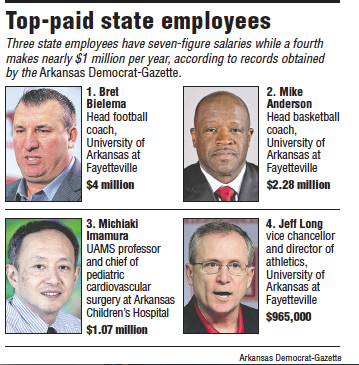The number of state employees who earn at least $100,000 a year increased by 119 this fiscal year to 2,585.
But that's the lowest growth in the six-figure salary list in at least the past six fiscal years. Past increases have ranged from 129 in fiscal 2010 to 164 in fiscal 2011.
Most of this fiscal year's increase has occurred at the state's higher-education institutions.
The number of $100,000-plus salaries at the state's two- and four-year colleges increased from 2,116 in fiscal 2014 to 2,220 in fiscal 2015, while their peers in state agencies increased from 350 to 365 in the same period. Those figures are based on the Arkansas Democrat-Gazette's collection of such information earlier this year.
"Higher ed is big business," said state Sen. Larry Teague, D-Nashville, who is co-chairman of the Arkansas Legislature's Joint Budget Committee.
More than half of the employees at the state's higher-education institutions who make at least $100,000 a year are employed at the University of Arkansas for Medical Sciences: 1,180 in fiscal 2015 -- up from 1,152 in fiscal 2014.
That 28-employee increase is the lowest at UAMS during at least the past six fiscal years.
"Practicing doctors make a good living, and that's part of the reason they are there and part of it is they care about people," said Teague. "But if they are giving up time out of practice to do something, then they deserve to be compensated for that, so I just don't have a problem with it."
Funding for the state government's 2,585 highest-earning employees comes from a variety of state, federal and private sources, including tuition, hospital billings and taxes.
The Democrat-Gazette compiled these figures from more than three dozen repositories of state employee salary information, and the figures reflect salaries from earlier this year.
Senate President Pro Tempore Jonathan Dismang, R-Searcy, said this is the type of information "we should take a closer look at than we do right now."
State Sen. Bryan King, R-Green Forest, doubts that the Republican-dominated Arkansas Legislature is going to ax any of the high-paid positions.
"We are not going to eliminate [them] unless the economy goes south," he said.
Despite promises by Republicans to rein in spending, "This fiscal conservative stuff didn't happen [after Republicans gained control of the Legislature in 2013]," King said. "I'll give Asa a pass because he's a new governor."
Republican Asa Hutchinson was sworn in as governor on Jan. 13 -- more than than halfway through fiscal 2015, which ends June 30.
He succeeded Democrat Mike Beebe, who had been governor the previous eight years.
Hutchinson said in an interview Thursday that his goal is to review positions in state government and determine whether they are "essential" and whether they could be consolidated with other positions to make state government more efficient.
Nearly four months ago, the governor issued an executive order requiring state agencies to get his approval before filling vacant positions. His executive order applies to most state agencies but not to agencies such as the state's higher-education institutions, Department of Highway and Transportation, Game and Fish Commission, or to legislative and judicial agencies.
Hutchinson said he has "limited control over higher ed" because the state's two- and four-year colleges are constitutionally independent agencies and "have to be competitive with the market.
"We need to be competitive to be able to hire the best people," he said.
But Hutchinson said he also wants to make government more efficient and level off the growth in the $100,000-plus list.
STATE EMPLOYEES
The top-paid state employee is Bret Bielema, head football coach at the University of Arkansas at Fayetteville.
He now makes $4 million a year, after getting a pay raise and a contract extension in February.
Bielema's new deal includes retention payments of $125,000, paid twice per year, while he remains with the Razorbacks. The UA portion of his 2015 salary is $3.25 million, with the Razorback Foundation paying $500,000, and the retention bonuses making up the final $250,000 to put the deal at $4 million.
UA hired Bielema in December 2012 from the University of Wisconsin, where he coached for seven years and led the Badgers to three consecutive Rose Bowl games.
Mike Anderson, UA's head basketball coach, is second on the list, earning $2.28 million.
In January, UA announced a contract extension for Anderson through the 2020 season.
Next is Michiaki Imamura, a UAMS professor and chief of pediatric cardiovascular surgery at Arkansas Children's Hospital, at $1.07 million. His salary is financed through patient care charges and private funds, said UAMS spokesman Leslie Taylor.
UA Athletic Director Jeff Long is the fourth-highest-paid state employee at $965,000.
In September 2007, Long was hired from the University of Pittsburgh, where he was athletic director, to replace Frank Broyles, Arkansas' athletic director from 1973-2008 and head football coach from 1958-76.
UAMS EMPLOYEES
UAMS added 28 $100,000-plus employees in fiscal 2015.
Their ranks increased to 1,180 because "we were able to recruit faculty for several key positions," hire doctors and other faculty and staff members for new programs, and open a new UAMS neighborhood clinic in west Little Rock, Taylor said.
UAMS is starting a physical therapy degree program at its Northwest Arkansas campus in Fayetteville and has already opened a rehabilitation clinic there. The Little Rock campus has also added a dental center and clinic, Taylor said.
"We are also opening a new orthopedic center on Shackleford West Boulevard in west Little Rock on Monday," Taylor said.
"We are looking for ways to increase clinical income, since we are so dependent on that to help fund our education and research missions," she said.
While the number of high-salary positions is increasing, there have been reductions in the ranks of employees elsewhere.
UAMS' total number of full-time and part-time employees has decreased from 10,175 last year to 10,055 this year, Taylor said.
UAMS' total projected revenue is roughly $1.26 billion in fiscal 2015 -- up from total revenue of about $1.25 billion in fiscal 2014, she said.
Most of its income is from patient revenue. UAMS is projecting patient revenue of $941.8 million in fiscal 2015, up from $906.5 million in fiscal 2014, Taylor said.
OTHER AGENCIES
The number of state employees who make at least $100,000 a year and work for state agencies other than higher-education institutions increased by 15 to 365 in fiscal 2015.
State Education Commissioner Johnny Key, a former Republican state senator from Mountain Home and one-time associate vice president for university relations at the UA System, is the highest-paid of these employees with a salary of $231,176.
Hutchinson nominated Key and the state Board of Education confirmed him in March. State law had to be changed for Key to qualify for the job. Either the education commissioner or deputy education commissioner has to meet the minimum requirements for education, experience and licensure for the job under the new law. Although Key doesn't meet the standard, his deputy Mike Hernandez does.
Nathaniel Smith, director of the state Health Department, is the second-highest-paid of these employees with a salary of $217,602 a year. He has been the department's director since 2013.
Several of the non-higher-education employees whose salaries now exceed $100,000 passed that threshold this year thanks to a 1 percent cost-of-living raise this fiscal year, state officials said.
The 2014 Legislature authorized 1 percent cost-of-living raises in fiscal 2015 for about 30,000 state employees who don't work for the state's higher-education institutions.
The average salary of about 28,000 state employees, who are on the Arkansas Administrative Statewide Information System, is $38,771 in fiscal 2015 -- up from $38,467 in fiscal 2014 -- said Kay Terry, the state's personnel administrator.
Employees at the state's higher-education institutions are among those who aren't on the Administrative Statewide Information System.
The salaries at the state's two- and four-year colleges vary widely, and an average was not available through the state Department of Higher Education.
The two- and four-year colleges decide on their own whether to grant pay raises, and they can tap funding sources other than state general revenue, such as tuition, fees and private funding sources.
At UAMS, classified employees were granted 1 percent raises in January retroactive to July 1, and nonclassified, nonfaculty employees received 2 percent raises starting in January for the remaining six months of fiscal 2015, Taylor said.
UAMS' physicians and other faculty members are not eligible for pay raises this fiscal year, she said.
THE PAST DECADE
The number of state employees who are paid at least $100,000 increased from 1,046 in fiscal 2005 to 2,585 in fiscal 2015. That includes an increase from 942 in fiscal 2005 to 2,200 in fiscal 2015 at the state's higher-education institutions, including UAMS' increase from 610 to 1,180.
The number of full-time state employees has increased from 51,007 in fiscal 2005 to 57,489 in fiscal 2015 as of Dec. 31, according to the state's budget office.
The state's expenditures for employees' salaries have increased from $2.058 billion in fiscal 2005 to $3.043 billion in fiscal 2014, according to the state's budget office.
SundayMonday on 05/10/2015

